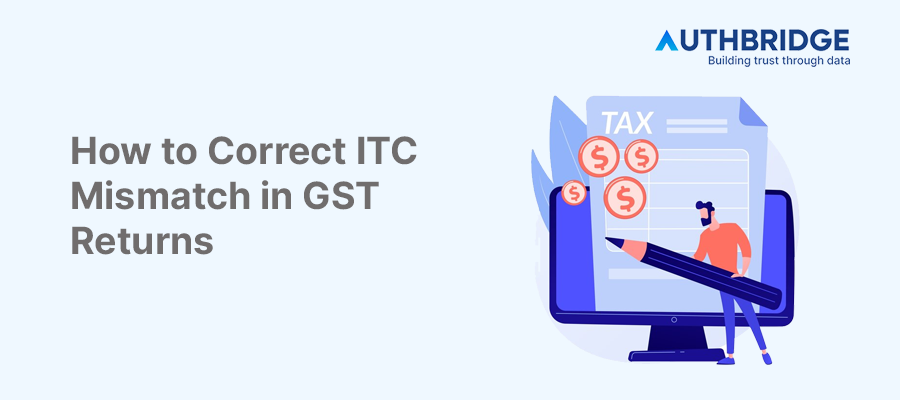Understanding ITC Mismatch In GST Returns: Identification And Correction Strategies

Understanding ITC Mismatch
Input Tax Credit (ITC) mismatch occurs when there is a discrepancy between the ITC claimed by a taxpayer in their GSTR-3B and the ITC available as per GSTR-2A or GSTR-2B. This can lead to challenges in claiming ITC, resulting in potential cash flow issues and compliance risks.
Common Causes of ITC Mismatch
ITC mismatches can arise due to various reasons, including:
- Invoices not uploaded by suppliers in their GSTR-1, leading to their absence in GSTR-2A/2B.
- Errors in invoice details such as GSTIN, invoice number, or tax amount.
- Delayed filing of GSTR-1 by suppliers, affecting the visibility of ITC in the relevant period.
Identifying ITC Mismatch
Tools and Reports for Identifying Mismatch
Taxpayers can use the reconciliation tool available on the GST portal or third-party software to compare their purchase register with GSTR-2A/2B. This helps in identifying missing invoices or discrepancies in invoice details.
Reconciliation of GSTR-2A with Purchase Register
The reconciliation process involves matching the invoices recorded in the taxpayer's purchase register with the invoices reflected in GSTR-2A/2B. This step is crucial for identifying mismatches and taking corrective actions.
Steps to Correct ITC Mismatch
Communicating with Suppliers
Upon identifying mismatches, taxpayers should communicate with their suppliers to rectify missing or incorrect invoices in GSTR-1. Suppliers can then file amendments in their subsequent GSTR-1 returns.
Adjusting Entries in Subsequent Returns
Taxpayers can adjust their ITC claims in subsequent GSTR-3B returns based on the corrected invoices reflected in GSTR-2A/2B. This ensures that the ITC claimed is accurate and compliant with GST regulations.
Role of GSTR-2B in ITC Reconciliation
Understanding GSTR-2B
GSTR-2B is a static statement generated for taxpayers, providing a summary of input tax credit available for a particular month. It includes information on all invoices uploaded by suppliers, making it a crucial document for ITC reconciliation.
Utilizing GSTR-2B for Accurate ITC Claims
Taxpayers should use GSTR-2B as the basis for claiming ITC in their GSTR-3B returns. Since GSTR-2B is generated after the 11th of the following month, it provides a comprehensive view of all eligible ITC for the previous month.
GST Laws on ITC Mismatch
The GST law mandates the reconciliation of ITC claimed by taxpayers with the details furnished by their suppliers in GSTR-1, which reflects in GSTR-2A/2B of the taxpayer. Failure to reconcile and correct mismatches can lead to denial of ITC claims and imposition of interest and penalties.
- Table 1: Legal Provisions for ITC Reconciliation
Provision | Description |
Section 42 of CGST Act | Mandates matching, reversal, and reclaim of ITC. |
Rule 69 of CGST Rules | Details the procedure for matching of ITC claims with GSTR-2A. |
Section 43 of CGST Act | Outlines the procedure for mismatched ITC and its rectification. |
Deadlines and Penalties for Non-compliance
Taxpayers are required to reconcile and correct any ITC mismatches within the specified deadlines to avoid interest and penalties. The interest is levied at 18% per annum for the period of delay in correcting the mismatch.
Advanced Reconciliation Techniques
Automated Reconciliation Tools
Many GST software solutions offer automated reconciliation features that can significantly reduce the time and effort required for matching ITC claims with GSTR-2A/2B data. These tools can automatically identify mismatches and facilitate communication with suppliers for corrections.
- Table 2: Features of Automated Reconciliation Tools
Feature | Benefit |
Auto-matching of Invoices | Reduces manual effort and errors in reconciliation. |
Real-time Alerts for Mismatches | Ensures timely identification and correction of discrepancies. |
Supplier Communication Module | Streamlines the process of notifying suppliers about mismatches. |
Periodic Review and Analysis
Conducting periodic reviews of ITC claims and reconciliation status helps in identifying patterns in mismatches and taking proactive measures to prevent future discrepancies. This can include training suppliers on compliance requirements or adjusting procurement practices.
Conclusion
Best Practices for Managing ITC Mismatch
To effectively manage and correct ITC mismatches, taxpayers should:
- Regularly reconcile GSTR-2A/2B with their purchase register.
- Communicate promptly with suppliers to correct any discrepancies.
- Utilize automated tools for efficient reconciliation.
- Stay updated on GST regulations and compliance requirements.
- Conduct periodic reviews and analysis to identify and address recurring issues.
Future Outlook on GST Compliance and ITC Reconciliation
As the GST framework continues to evolve, it is expected that the process for ITC reconciliation will become more streamlined, with enhanced support for automated tools and clearer guidelines for taxpayers and suppliers. Taxpayers should stay informed about these changes to ensure seamless compliance and optimization of their ITC claims.
Category

Abhinandan Banerjee
(Associate Manager - Marketing)
Abhinandan is a dynamic Product and Content Marketer, boasting over seven years of experience in crafting impactful marketing strategies across diverse environments. Known for his strategic insights, he propels digital growth and boosts brand visibility by transforming complex ideas into compelling content that inspires action.



